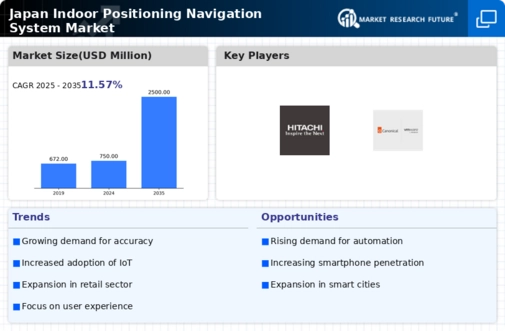The indoor positioning navigation system market in Japan is characterized by a dynamic competitive landscape, driven by technological advancements and increasing demand for precise location services across various sectors. Key players such as Mitsubishi Electric (Japan), NEC Corporation (Japan), and Sony Corporation (Japan) are at the forefront, each adopting distinct strategies to enhance their market presence. Mitsubishi Electric (Japan) focuses on innovation through the development of advanced sensor technologies, while NEC Corporation (Japan) emphasizes partnerships with local governments to implement smart city initiatives. Sony Corporation (Japan) leverages its expertise in consumer electronics to integrate indoor positioning capabilities into its products, thereby enhancing user experience. Collectively, these strategies contribute to a competitive environment that is increasingly oriented towards technological differentiation and collaborative ventures.
In terms of business tactics, companies are localizing manufacturing and optimizing supply chains to enhance operational efficiency. The market structure appears moderately fragmented, with several players vying for market share. However, the influence of major companies is substantial, as they set benchmarks for innovation and service quality. This competitive structure fosters an environment where smaller firms may struggle to keep pace with the rapid technological advancements and customer expectations set by industry leaders.
In November 2025, NEC Corporation (Japan) announced a strategic partnership with a leading telecommunications provider to enhance its indoor positioning solutions. This collaboration aims to integrate advanced 5G technology with indoor navigation systems, potentially revolutionizing the way users interact with their environments. The strategic importance of this partnership lies in its potential to provide real-time data analytics and improved accuracy, thereby positioning NEC Corporation (Japan) as a leader in the next generation of indoor navigation solutions.
In October 2025, Sony Corporation (Japan) launched a new line of smart devices equipped with enhanced indoor positioning capabilities. This move is indicative of Sony's commitment to integrating cutting-edge technology into consumer products, thereby enhancing user engagement and satisfaction. The introduction of these devices not only strengthens Sony's market position but also reflects a broader trend towards the convergence of consumer electronics and location-based services.
In December 2025, Mitsubishi Electric (Japan) unveiled a new indoor positioning system designed specifically for large-scale retail environments. This system utilizes advanced machine learning algorithms to optimize customer flow and enhance the shopping experience. The strategic significance of this development lies in its potential to transform retail operations, providing businesses with actionable insights that can drive sales and improve customer satisfaction.
As of December 2025, the competitive trends in the indoor positioning navigation system market are increasingly defined by digitalization, sustainability, and the integration of artificial intelligence (AI). Strategic alliances are becoming more prevalent, as companies recognize the value of collaboration in driving innovation and expanding market reach. Looking ahead, competitive differentiation is likely to evolve from traditional price-based competition to a focus on technological innovation, reliability of supply chains, and the ability to deliver tailored solutions that meet the specific needs of diverse industries.













Leave a Comment